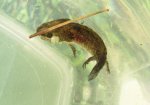Brian M
Member
- Joined
- Dec 29, 2008
- Messages
- 41
- Reaction score
- 6
- Points
- 8
- Age
- 45
- Location
- Narragansett, Rhode Island
- Country
- United States
Hi i'm brian from narragansett rhode island. I have a B.S. in environmental science and management. My true love is vernal pools and trying to protect them since many wetland regulations leave these unprotected and vulnerable to being filled. I own a spotted salamander{Ambystoma maculatum} i caught this as a newly hatched larva 3 years ago this past may. I also have a cb {salamandra salamandra terrestris} female who i purchased back in april of 2007. I house her in a 48 oceanic tank with 2 marbled newts{Triturus marmoratus} which i purchased cb this march. I look foward to adding new salamandra to my collection especially more salamandra salamandra terrestris and hopefully one day the italian fire salamander.


